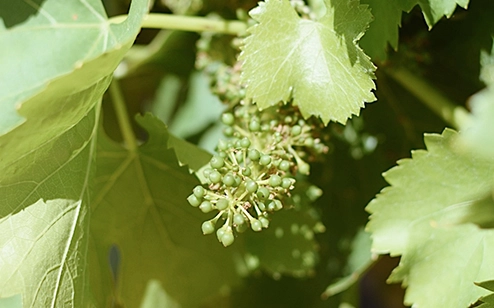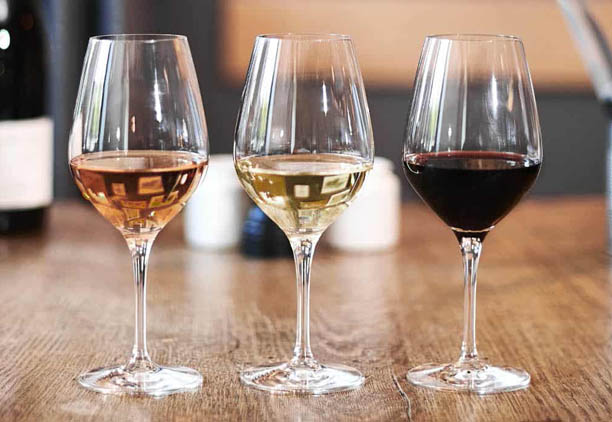Expert guide to the viticultural calendar
Un livre blanc de Vignobles & Compagnie
🌱 Introduction: understanding the natural rhythm of the vine
Viticulture is an ancient art based on an intimate understanding of the natural cycle. Each month of the year brings its challenges, opportunities, and specific interventions in vineyard management. This expert guide reveals the secrets of the viticultural calendar, the fruit of generations of know-how passed down from winemaker to winemaker.
At Vignobles & Compagnie, we believe that deep knowledge of these cycles is the key to excellence. From winter dormancy to summer harvest, each stage reveals the fascinating complexity of the vine and the expertise needed to reveal the potential of each terroir.
❄️ Chapter 1: winter – time of rest and preparation
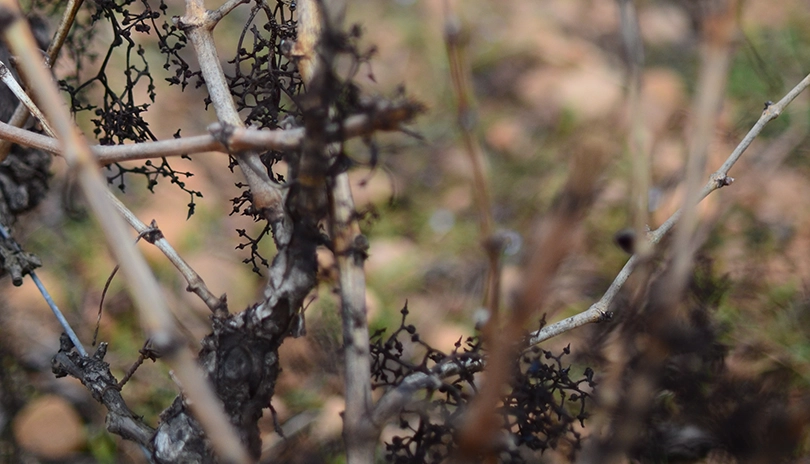
January: dormancy, when the vine rests
Winter marks the beginning of a crucial period in the vegetative cycle: dormancy (temporary cessation of plant growth). This phase, which generally extends from late November to mid-February, represents much more than simple rest for the vine. It’s a refined survival strategy, developed through evolution, that allows the plant to resist winter hardships.
During dormancy, the vine drastically reduces its metabolic activity. This remarkable adaptation allows the organism to carefully conserve its energy, stored in the roots and trunk as starch. The buds, future bearers of the harvest, naturally protect themselves in their scales, creating an insulating microclimate that preserves them from frost.
This period of apparent rest conceals intense underground activity. The roots continue their work of soil exploration, sometimes extending several meters to draw the nutritive elements that will nourish future vegetation. It’s also during this phase that bud differentiation occurs: some will become vegetative (leaf-bearing), others will be fertile (grape-bearing).
For the experienced winemaker, dormancy is never synonymous with inactivity. It’s the privileged moment to observe, analyze, and plan. Meticulous examination of the previous year’s wood reveals the secrets of the future harvest: cane diameter, internode length, wood color – all indices that will guide pruning decisions.
February: the ancient art of pruning
If the vine were abandoned to itself, it would quickly return to its wild state as a climbing liana. Wood growth would then prevail over fruiting, producing luxuriant but sterile vegetation. This is why pruning represents the most decisive human intervention in vineyard management.
Pruning is based on a fundamental principle: the selection of the most fertile buds and best position. These are mainly located on one-year-old wood, that which grew during the previous season. This rule, discovered empirically by our ancestor winemakers, now finds its scientific explanation in vine physiology.
The pruning process follows a rigorous methodology. Pre-pruning facilitates work by clearing the vine structure, then comes the elimination of dead wood, true entry points for cryptogamic diseases (diseases caused to a plant by a fungus or other filamentous organism). The crucial step consists of selecting the year’s shoots, keeping at least three buds per branch. This “three eyes” rule ensures a balance between production and quality according to legend. The number of buds varies according to grape variety and appellation area.
Each cut of the secateurs reveals the winemaker’s philosophy. Severe pruning will favor concentration and quality, while more generous pruning will aim for higher yields. This strategic decision is based on multiple factors: vine age, grape variety vigor, terroir characteristics, or the qualitative objectives of the cuvée.
Experience forges the pruner’s eye. Over the vintages, they learn to “read” each vine, to anticipate its reaction, to adapt their gesture to each plant’s specificities. This expertise, transmitted from generation to generation, constitutes one of the foundations of French viticultural know-how.
🌿 Chapter 2: the spring awakening
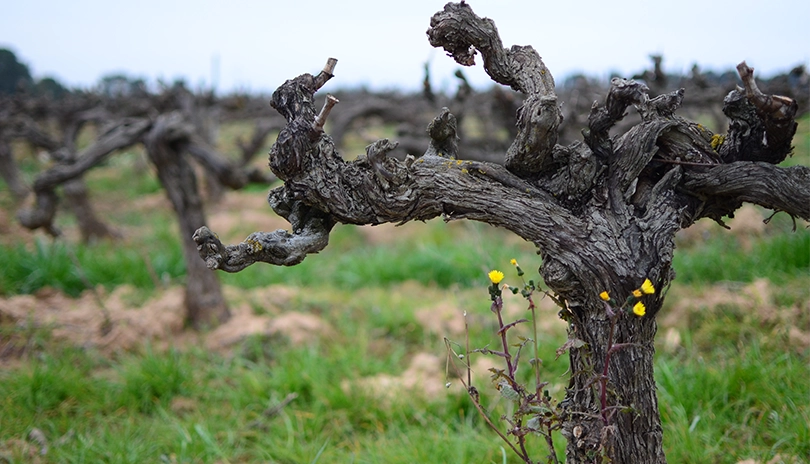
March: bud break, first signal of awakening
Spring marks a spectacular transition in vine life. When temperatures rise durably above 10°C, a fascinating phenomenon occurs: bud break (action of blooming). This poetic term designates the bursting of buds, first visible signs of vegetative awakening.
The process begins with sap rise. This lymphatic circulation, sometimes visible as “tears” at pruning wound sites, testifies to the resumption of root system activity. The hydrostatic pressure thus created gradually swells the buds, until their protective envelope bursts.
In each opening bud hides a miniature universe. With microscopes, botanists have revealed the complexity of these organs: main bud, secondary backup bud, leaf primordia, and even, for fertile buds, the first sketches of future grape clusters. Nature thus condenses in a few cubic millimeters all the potential of a harvest.
The “bud in cotton” stage constitutes a critical moment. The fine downy envelope protecting young shoots doesn’t resist late frosts. This is why this period mobilizes all winemakers’ attention, ready to implement different protection techniques: candles, braziers, water spraying, or even helicopters to stir the air and avoid thermal stratification, although these techniques are avoided as much as possible for environmental reasons.
April: surveillance and protection against frost
After the euphoria of bud break comes a period of intense vigilance. Young shoots, still tender and water-filled, remain particularly vulnerable to spring frosts. These meteorological episodes, feared by all winemakers, can destroy in one night the hopes of an entire harvest.
The fight against frost mobilizes ancestral and modern technologies. Traditional methods, like lighting braziers or candles, create a protective microclimate through thermal convection. More recently, water spraying exploits the phenomenon of latent heat: freezing water releases calories, maintaining plant tissues at 0°C instead of dropping to negative temperatures.
Connected weather stations now allow real-time monitoring of climatic conditions. Automatic alerts, risk zone mapping, micro-local forecasts: modern technology allies with traditional know-how to optimize vineyard protection.
This period also reveals the importance of plot and exposure choice. Vineyards planted on hillsides generally benefit from better natural protection against frost, as cold air tends to flow toward low points. This empirical knowledge has guided the establishment of quality vineyards for centuries.
🌸 Chapter 3: spring’s vegetative explosion
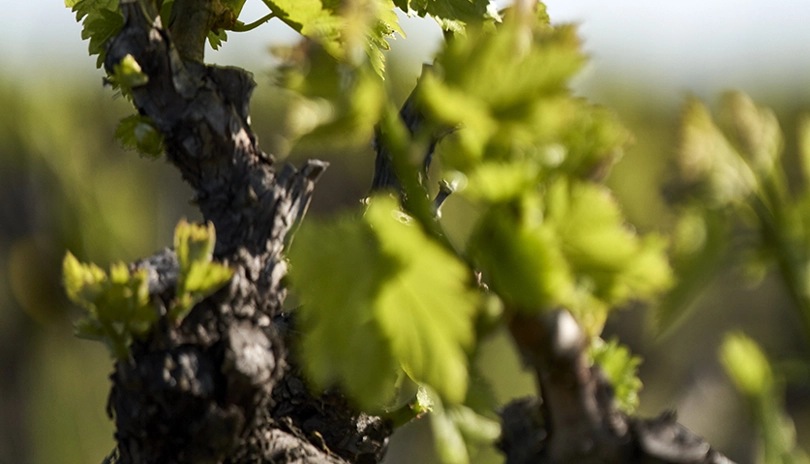
May: growth acceleration and soil work
May marks entry into a period of intense vegetative activity. Rising temperatures and lengthening days trigger exponential growth of young shoots. This phase of spring effervescence requires constant surveillance and precise interventions.
Soil work regains capital importance during this period. Far from being a simple tradition, these mechanical interventions respond to precise agronomic objectives. Hoeing, which consists of loosening the surface layer, favors rainwater infiltration while limiting evaporation through capillary rise. This ancestral technique, summarized by the adage “one hoeing equals two waterings,” retains all its relevance in sustainable viticulture. This work also breaks the vine’s surface roots so it extends deeper and ensures easier access to water resources for the hot season.
Desuckering constitutes another crucial intervention of this period. This delicate operation consists of eliminating suckers, these non-productive shoots that uselessly draw from the vine’s reserves. Each glance, each gesture of the winemaker influences the plant’s future balance. Too severe desuckering weakens the vine, while insufficient desuckering harms future cluster concentration.
Fertigation, a modern technique of nutritional input, also finds its place in May’s calendar. This method allows dissolving fertilizing elements directly in irrigation water, ensuring immediate availability for active roots. This art consists of precisely dosing these inputs based on foliar analysis (phosphorus and potassium availability in leaves allowing soil analysis and its capacity to retain these mineral elements) and observation of vegetative vigor.
June: flowering, critical moment of the cycle
Flowering represents one of the most tense and spectacular moments of the viticultural cycle. This phase, which generally occurs between the sixth and thirteenth weeks after bud break, directly conditions the quantitative and qualitative potential of the future harvest.
The process begins with the emergence of tiny sepals containing coiled petals. These formations, which resemble miniature versions of future grape clusters, evolve rapidly under the effect of temperature and humidity. The opening of sepals then reveals reproductive organs: male stamens loaded with pollen and receptive female pistil.
The cultivated vine has the particularity of being hermaphroditic, carrying male and female organs on the same flower. This characteristic, fruit of centuries of selection, ensures efficient pollination even in the absence of external pollinating agents. Self-fertilization thus guarantees species reproduction in sometimes difficult climatic conditions.
Pollination success depends closely on meteorological conditions. Hot and dry weather favors anther dehiscence (opening of reproductive organs) and pollen dispersion. Conversely, rain, strong wind, or too-cool temperatures can compromise this delicate phase. This is when the dreaded phenomena of coulure and millerandage appear.
Coulure is characterized by premature fall of unfertilized flowers. This phenomenon, particularly frequent in certain grape varieties like Merlot or Gewürztraminer, can drastically reduce yields. Millerandage, meanwhile, produces berries of unequal size in the same cluster, compromising maturation homogeneity.
🍇 Chapter 4: summer and fruit formation
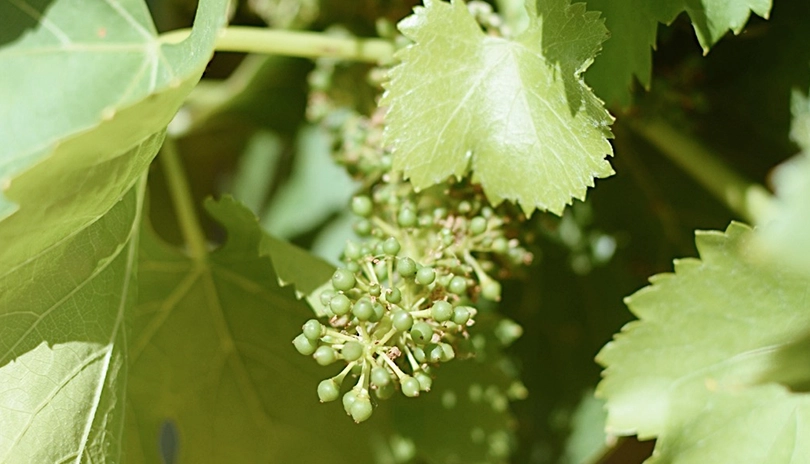
July: fruit set, birth of future grapes
After successful pollination comes an equally crucial phase: fruit set. This technical term designates the transformation of fertilized flowers into young fruits. It’s during this period that the quantitative profile of the future harvest truly takes shape.
Fertilized ovules give birth to seeds, true seeds that develop simultaneously with the future grape berry’s pulp. This synchronous growth isn’t random: seeds produce growth hormones (gibberellins and auxins) that stimulate berry development. This is why seedless grapes, resulting from parthenocarpy (which forms without fertilization; without seeds), generally present smaller berries.
Fruit set success conditions not only grape quantity but also their future quality. Homogeneous fruit set over time ensures uniform maturation, a key factor in excellence. Conversely, extended fruit set produces heterogeneous clusters, mixing ripe and green berries at harvest time.
This phase reveals the importance of the vine’s nutritional balance. Excess nitrogen favors vegetative vigor at the expense of fruiting. Conversely, boron deficiency (similar to carbon) can disrupt pollen tube formation and compromise fertilization. The experienced winemaker monitors these subtle balances through observation and regular foliar analysis.
August: veraison, spectacular transformation
Veraison is the transitional phase of the viticultural cycle. This transformation, which generally begins in mid-July and ends in late August, marks the passage from vegetative development to maturation.
The phenomenon begins with a notable slowing of berry growth. Growth hormones are no longer synthesized and the vine redirects its energy toward accumulating reserves in the fruits. This is when synthesis of compounds that will give wine its organoleptic characteristics begins.
The most striking visual transformation concerns berry color. Black grape varieties see their grapes evolve from initial green to purple then black tones through anthocyanin synthesis in the skin. These pigments, responsible for red wine color, gradually accumulate in the fruit’s epidermal cells.
Parallel to these chromatic changes, the berries’ chemical composition is profoundly modified. The content of malic and tartaric acids, initially very high, gradually decreases. Simultaneously, sugars (glucose and fructose) accumulate in the pulp, derived from photosynthesis and transported by elaborated sap.
The official veraison date is conventionally set when 50% of a plot’s berries have changed color. From this benchmark, winemakers know there generally remain 40 to 50 days before optimal maturity for harvest. This empirical knowledge, verified vintage after vintage, guides harvest planning.
🌾 Chapter 5: autumn and harvest
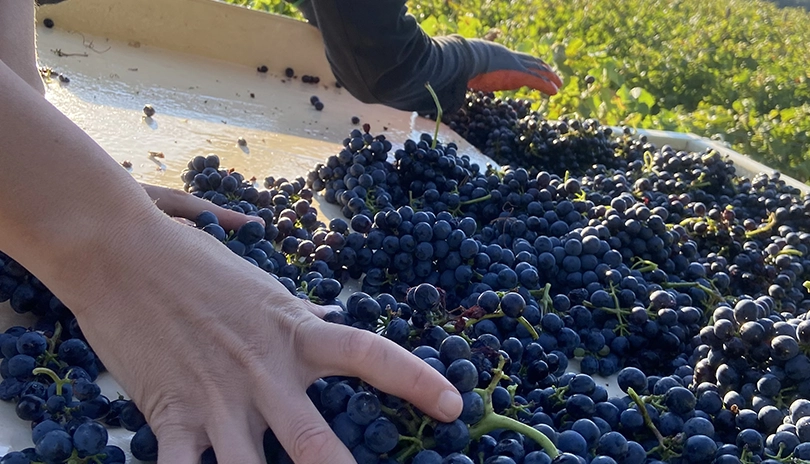
September: approaching harvest
September marks the culmination of all the winemaker’s annual work. Grapes complete their maturation under summer’s last fires, accumulating sugars and developing their aromatic precursors. This ultimate phase requires constant surveillance and crucial decision-making.
Determining the optimal harvest date mobilizes all the winemaker’s expertise. Several parameters come into play: technological maturity (sugar content and acidity), phenolic maturity (color, tannins, aromas), and aromatic maturity. These three components don’t necessarily evolve synchronously, requiring thoughtful compromises.
Sampling and tasting in plots multiply. Each grape variety, each exposure, each soil type presents its own evolution. The professional’s trained eye detects subtle nuances that distinguish a technically ripe grape from a perfectly balanced grape for great wine elaboration.
This crucial period’s meteorological conditions directly influence final quality. Dry and sunny weather favors aroma concentration and sanitary stability. Conversely, early rains can dilute musts and favor cryptogamic disease development like botrytis (parasitic fungus species).
October: harvest in full swing
October is the viticultural year’s pinnacle: harvest. This intense period mobilizes all teams and focuses attention on harvest quality. Each gesture, each decision influences future wines’ qualitative potential.
The choice between manual and mechanical harvest depends on multiple factors. Manual harvest, more respectful of fruit, allows plot selection and rigorous sorting. Experienced harvesters naturally eliminate defective clusters, insufficiently ripe or disease-altered grapes. This selectivity, impossible to reproduce mechanically, justifies this method’s extra cost for high-end cuvées. Moreover, it’s mandatory in certain appellation specifications.
Night harvesting, practiced for whites and rosés, preserves grapes’ aromatic freshness. Cooler nighttime temperatures limit early oxidation and allow starting vinifications in optimal conditions. This technique, inspired by hot countries, gains popularity facing climate warming.
Transporting and receiving grapes at the winery requires particular precautions. Using small containers limits berry crushing and preserves harvest sanitary integrity. The sorting table, emblematic equipment of prestigious estates, allows ultimate quality control before vinification.
Vineyard situation diversity sometimes complicates harvest decisions. Young and old vines, differently exposed plots, early and late grape varieties: so many parameters requiring an individualized approach. The cellar master must orchestrate this complexity to optimize each lot’s potential.
🍂 Chapter 6: cycle end and winter preparations

November: wine aging and winter preparation
November marks a transition in viticultural activity. While harvests end, attention turns to the cellar where fermentations begin. Simultaneously, the vineyard begins its preparation to face approaching winter.
New wine aging mobilizes strong oenological expertise. Alcoholic fermentations (sugar transformation into alcohol by yeasts) require constant surveillance. Temperature, density, tasting: each parameter influences future wines’ organoleptic profile. Microbiological and chemical analyses complete sensory evaluation to finely pilot these complex processes.
In the vineyard, leaves begin yellowing and reddening, testifying to photosynthetic activity slowing. This foliar autolysis phase allows the vine to recover part of the nutritive elements contained in leaves, which migrate toward perennial organs (trunk, roots) to constitute winter reserves.
It’s also the period for last soil work before winter. Hilling consists of bringing soil to vine bases to protect them from winter rigors. This practice, particularly important in northern regions, preserves the graft point and facilitates spring vegetative recovery.
December: winter rest and planning
December closes the annual cycle and already opens next year’s perspectives. The vine progressively enters dormancy while the winemaker takes stock of the past campaign and prepares future strategies.
Analyzing the year’s results allows refining viticultural practices. Yields per plot, sanitary quality, must analytical profiles: all this data nourishes reflection to optimize future practices. This scientific approach, allied with ancestral experience, characterizes modern quality viticulture.
It’s also time to plan investments and replantings. Choosing rootstocks, clones, planting densities is based on past performance analysis and foreseeable climate evolution. These strategic decisions commit the operation for several decades.
Team training also finds its place in this winter calendar. Know-how transmission, new technology training, environmental issue awareness: winter becomes a time of sharing and learning to prepare future challenges.
🔍 Chapter 7: technical expertise in service of excellence
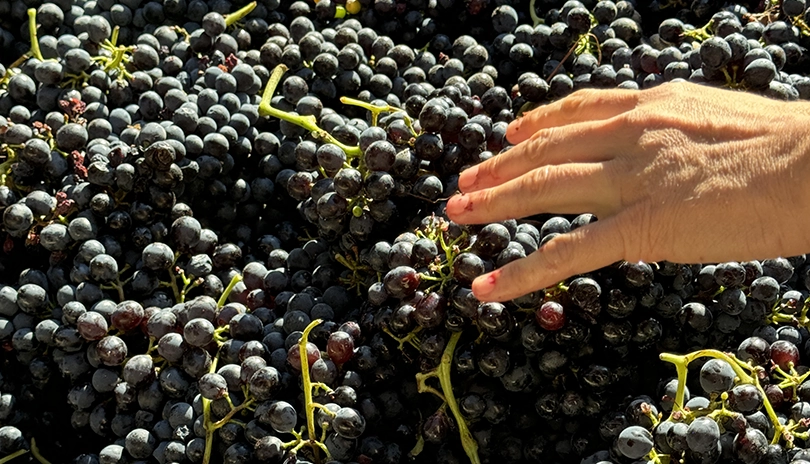
Science in service of tradition
Modern viticulture harmoniously combines millennial tradition and technological innovations. This synthesis characterizes Vignobles & Compagnie’s approach, where technical expertise serves a philosophy of uncompromising quality.
Foliar analysis reveals vines’ nutritional state with unequaled precision. Deficiencies in major elements (nitrogen, phosphorus, potassium) or trace elements (boron, zinc, manganese) can be detected early and corrected by targeted inputs. This preventive approach avoids imbalances that would compromise harvest quality.
Connected meteorology transforms climate risk management. Temperature, humidity, wind speed sensors: an automatic station network permanently monitors vineyard microclimatic conditions. Automatic alerts allow preventive interventions against frost, cryptogamic diseases, or pests.
Satellite imagery and drones equipped with multispectral sensors revolutionize plot approach. These technologies allow mapping vegetative vigor, detecting water stress zones, or localizing disease outbreaks. This precision viticulture optimizes interventions and preserves the environment.
Climate change adaptation
Climate warming imposes new viticultural strategies. Advancing harvest dates, observed throughout French vineyards, testifies to this evolution. At Vignobles & Compagnie, this adaptation involves complete revision of cultural practices.
Water management becomes crucial in this context. Localized irrigation, long taboo in French viticulture, finds its legitimacy facing recurrent drought episodes. Tensiometric probes allow finely piloting these inputs, respecting vine physiological needs without compromising terroir expression.
Inter-row grassing participates in this adaptation strategy. Vegetative cover limits evaporation, favors soil biological life, and regulates vine vigor. Grass species choice (grasses, legumes, crucifers) directly influences vineyard nutritional and water balance.
Genetic modifications, through varietal selection or clonal improvement, also open adaptation perspectives. Disease resistance, drought tolerance, high temperature adaptation: so many criteria guiding today’s applied research programs.
🍀 Chapter 8: terroir, unique expression of a place
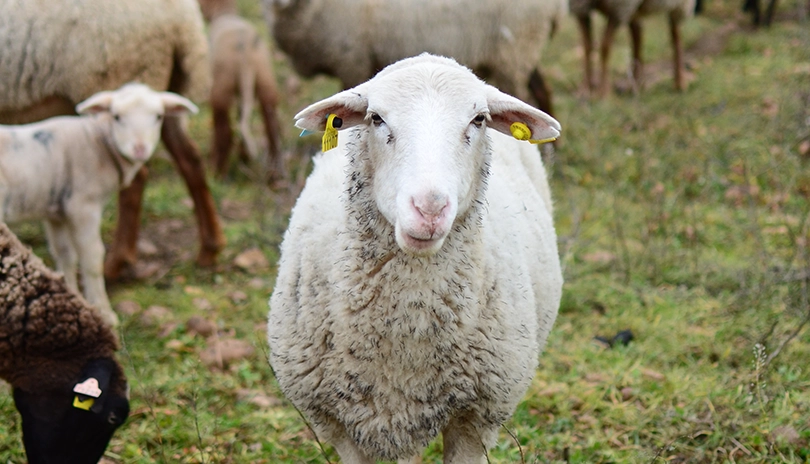
Understanding soil influence
Terroir constitutes the foundation of quality viticulture. This complex notion encompasses all natural factors influencing vineyard expression: soil, subsoil, climate, exposure, topography. At Vignobles & Compagnie, fine understanding of these interactions guides all technical decisions.
Pedological analysis reveals each plot’s personality. Texture (clay, silt, sand proportion) directly influences water and thermal regulation. Clay soils retain water and gradually restore it, favoring regular vine feeding. Sandy soils, more draining, induce controlled water stress that concentrates aromas.
Soil chemical composition determines the nutritional profile available to the vine. Active limestone, organic matter content, cation exchange capacity: so many parameters modulating root absorption. This knowledge allows adapting fertilizer inputs and optimizing varietal expression.
Subsoil plays an often underestimated role in terroir expression. Its geological nature influences deep drainage, water reserve, and rooting. Vineyards established on rocky bedrock develop deep root systems that draw from specific mineral reserves, contributing to wine complexity.
Varietal expression and blending
Each grape variety differently expresses terroir characteristics. This expression diversity justifies the plot approach developed by Vignobles & Compagnie, where each variety is cultivated according to its specific requirements.
Syrah particularly well reveals northern terroir nuances. Its extended vegetative cycle allows progressive maturation that preserves aromatic freshness. Granitic soils sublimate its peppery notes, while limestone terrains develop its floral aromas.
Grenache, Mediterranean grape variety par excellence, expresses the South’s warmth and generosity. Its drought resistance allows it to prosper on the most arid terroirs. Blending with Syrah and Mourvèdre creates the complexity sought in great southern Rhône wines.
Mourvèdre brings structure and aging potential to blends. This late grape variety requires privileged exposures to reach full maturity. Its aging aptitude enriches the aromatic palette of age-worthy wines.
The art of blending reveals the winemaker’s talent. Each plot lot brings its personality: fruit, structure, elegance, power. Final balance results from this subtle alchemy between terroirs and grape varieties, guided by experience and tasting.
💭 Conclusion: toward viticulture of excellence, but above all… sustainable!
The vine cycle reveals viticulture’s fascinating complexity. Each month brings its challenges and opportunities, requiring from the winemaker pointed technical expertise and refined artistic sensitivity. This synthesis between science and tradition describes the entire philosophy developed by Vignobles & Compagnie for several years.
Climate evolution imposes new challenges that stimulate innovation. Varietal adaptation, cultural practice optimization, precision technologies: so many tools serving environmentally respectful viticulture guaranteeing quality.
Transmitting this know-how constitutes a major stake for the future. Training new generations, sharing experience, innovating while preserving terroir identity; such is the mission our company has set itself. Well beyond technique, viticulture remains an art of living, a philosophy uniting man to his land. Each vintage tells a unique story, that of a year of work, observation, and passion. It’s this story we wish to share, so that tradition and excellence of our terroirs endure
© 2024 Vignobles & Compagnie – Tous droits réservés
Other sources to further your knowledge:
- Le calendrier des travaux de la vigne
- Les stades phénologiques de la vigne
- Travail de la vigne et du sol
